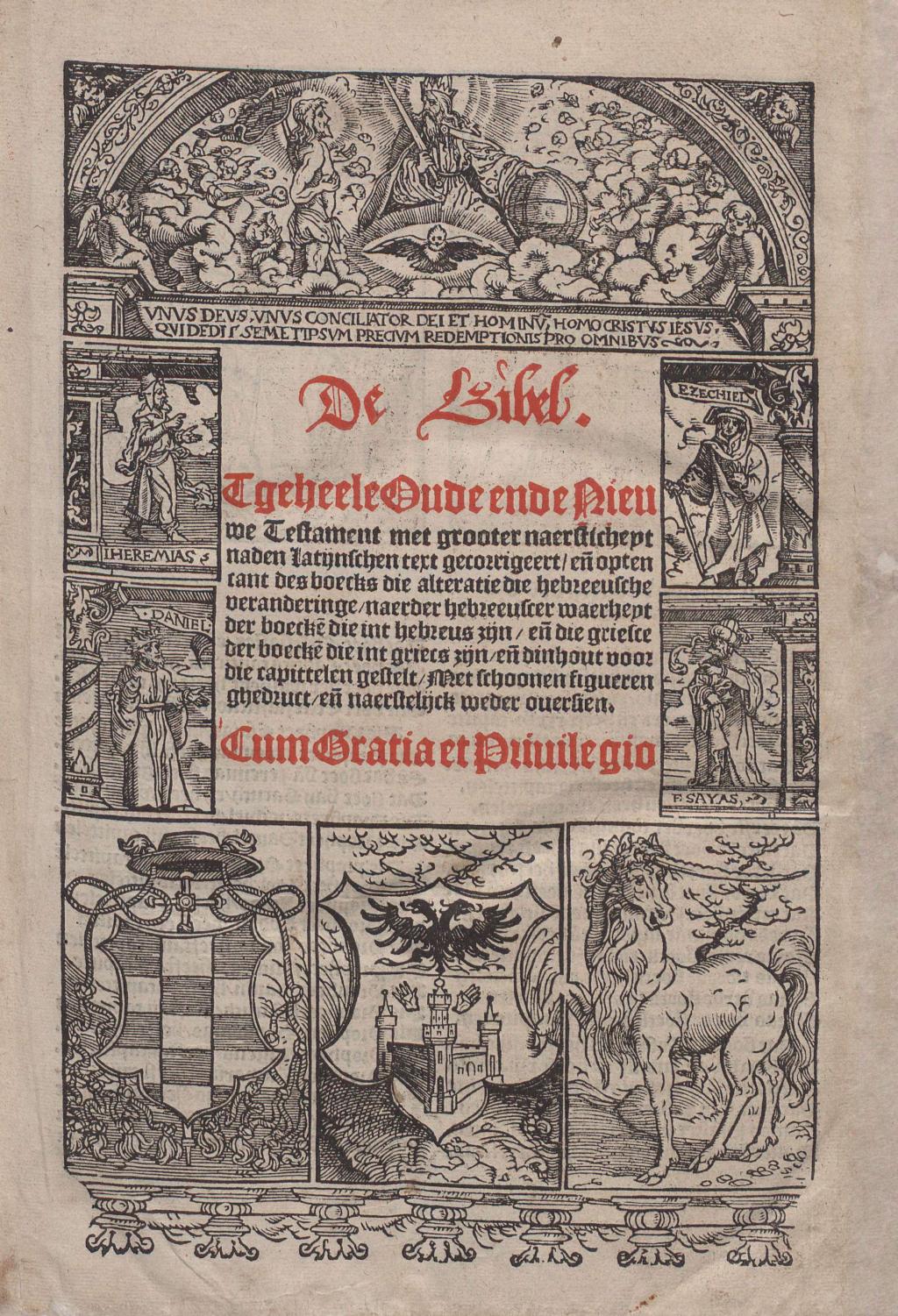Vorsterman Bible
De Vorsterman Bijbel
Willem Vorsterman
by Arnoldia Pienaar

| Title | Vorsterman Bible |
|---|---|
| Contributor(s) | Willem Vorsterman |
| Date | 1528-1545 |
| Place | Antwerp, Belgium |
| Format | |
| Language(s) | Dutch vernacular |
| Source | NBG Bijbels Digitaal |
The Vorsterman bible refers to a set of Bible editions published between 1528 and 1545 by the Antwerp based printer, Willem Vorsterman.
Willem Vorsterman was one of the biggest printers in Antwerp for the first half of the 16th century, publishing around 400 titles during the period from 1504 to 1543. He published works in a wide range of languages and genres, some of them including prose, history, devotional works, educational material and Latin editions of Erasmus. The languages they were published in included Latin, English, French, Dutch, Spanish and Danish. Vorsterman also published at least 19 editions of the Bible, twelve of which were in Dutch.
Vorsterman published his first complete edition of the Bible translated in Dutch vernacular in 1528. This was the first edition of the Vorsterman Bible which saw nine print runs in total. The intervals in which they were published were 1528,1529,1531,1532,1534,1542,1544 and 1545.
Overall, there aren’t many differences between these editions. The edition of 1528 is very similar to the one of 1531, which is again very similar to the one of 1544. There are some minor differences between the editions that include small corrections and different title pages.
The publication of Vorsterman’s complete edition of the Bible in Dutch came two years after the publication of the Liesvelt Bible in 1526. The Liesvelt Bible was the first complete edition of the Bible in Dutch vernacular printed by Jacob van Liesvelt, one of Vorsterman’s contemporaries also based in Antwerp. The Liesvelt Bible was mostly based on Luther’s translations of the Latin Vulgate and was supplemented by Liesvelt’s own translations of the Vulgate, which in turn served as a basis for Luther’s further translations of the Vulgate.
The Vorsterman Bible is a complete edition of the Bible that contains all the books of the Old and New Testament, along with a prologue, maps and illustrations, and other accompanying materials. Included on the title page is the crest of the city of Antwerp, a seal of Ximenes, and the printers mark of Willem Vorsterman. Most of the editions were printed from the same wooden blocks.
The title page and prologue of the Vorsterman Bible claims the publication had been granted full permission from church and state figures, and that the translation adheres strictly to the Latin Vulgate source text, and can thus be seen as an authoritative and standard translation. The title page bears the crest of Ximenes and the edition contains an extract claiming to have been granted consent from Claes Van Ligne, a scout of Antwerp, and Niclaes Coppijn, deacon of the church of Saint Peter in Leuven and chancellor for the university of Leuven.
According to the title page and prologue the translation of the Vorsterman bible used the Latin Vulgate as a source text. Included in the margins are also translations of the original Hebrew text which is based on the Complutensische Polyglot Bible edition of 1522, originally published in Alcala under the authority of the Pope. The prologue explains that the addition of these Hebrew texts serve only to provide clarity for the reader.
Although the Vorsterman Bible emphasizes its claim as an authoritative standard text of the Dutch vernacular Bible, research has uncovered that the claims of the title page and prologue are not entirely true. It seems that the Vorsterman Bible has a lot of similarities to the Liesvelt Bible. In instances where the Liesvelt Bible deviates from the Latin Vulgate the Vorsterman Bible remains faithful to it and includes Liesvelt translations in the margins. Furthermore it appears that the translation also relied on Old Testament translations of 1525 by Hans Ruremund.
In light of this research many claims have been made about the readership of the Vorsterman Bible. Bruin & Braeyer (1993:118) argues that the Vorsterman Bible was relatable to an alternative audience that thought differently about Christianity, and thus it appealed to a reformist audience (AUGUSTIJN).
The Vorsterman Bible achieved great commercial success, certainly because it was so richly illustrated. The 1528 edition contains 225 illustrations, while the 1531 edition kept 110 of them. These illustrations are credited to Jan Swarts and Lucas van Leyden.
In spite of this commercial success the bible was ultimately banned in 1546 and was never fully recognized by the church as an official translation. The next bible printed in the Dutch vernacular was the Leuvense Bible in 1548, and it mentions the Vorsterman Bible as a dissident edition containing many mistakes and contradictions.
Bibliography
AUGUSTIJN, C. “DE VORSTERMANBIJBEL VAN 1528.” Nederlands Archief Voor Kerkgeschiedenis / Dutch Review of Church History, vol. 56, no. 1, 1975, pp. 78–94. JSTOR, http://www.jstor.org/stable/24007207 Accessed 1 Dec. 2022.
Hans Beelen. “Verantwoording van de digitale uitgave van de Vorstermanbijbel (1528/1531).” De Vorsterman Bijbel (ca. 1528-1531), DBNL (KB, nationale bibliotheek), 2022, https://www.dbnl.org/tekst/_vor003vors01_01/_vor003vors01_01_0001.php Accessed 1 Dec. 2022.



